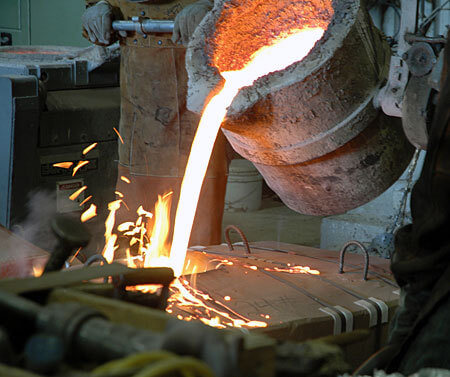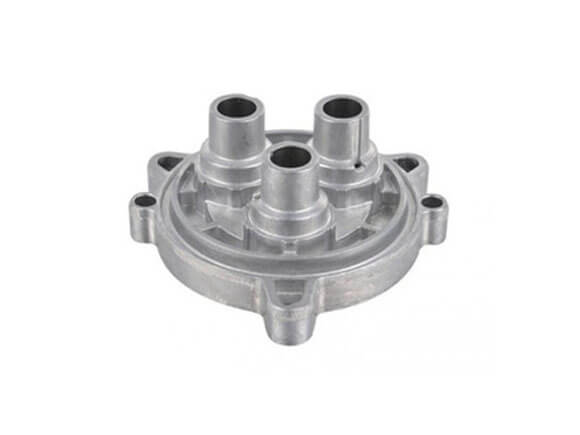Everything You Should Know About Precision aluminum casting Materials and Alloys
Wiki Article
Aluminum Casting Explained: Secret Facts and Insights for Market Professionals
Aluminum casting acts as a vital procedure in contemporary production, shaping parts across numerous industries. Its varied techniques, such as sand and die casting, accommodate various production demands. The special homes of aluminum alloys boost their applicability, yet tests remain in preserving top quality and efficiency. Recognizing these aspects is crucial for market specialists. What are the most current advancements and finest techniques that can better enhance this procedure?Overview of Aluminum Casting Processes

Crucial element of aluminum casting processes consist of the prep work of mold and mildews, which may be made from sand, metal, or ceramic materials, depending upon the intended use. In addition, temperature level control is critical to guarantee appropriate melting and solidification of aluminum.
The casting procedure permits for complex styles and can achieve high degrees of dimensional precision. When cooled, the castings may undertake ending up operations such as machining or surface therapy to satisfy particular performance criteria. In general, aluminum casting acts as a versatile production method, efficiently fulfilling the diverse needs of numerous industries.
Kinds of Aluminum Casting Techniques
In the domain of aluminum casting, numerous methods are used to accomplish different outcomes. Sand casting techniques give versatility and cost-effectiveness for complex forms, while die casting processes provide high accuracy and effectiveness for automation. Comprehending these approaches is vital for picking the suitable method based upon job needs.Sand Casting Techniques
Sand casting strategies represent a basic method in aluminum casting, where sand is made use of as a mold and mildew product to shape liquified steel. This process entails creating a pattern from the wanted part, which is then positioned in a sand blend to create a mold and mildew. The sand is compacted around the pattern, and after elimination, it develops a cavity in the shape of the part. Molten aluminum is poured into this tooth cavity, permitting it to cool down and strengthen. One significant advantage of sand casting is its convenience; it can suit huge parts and intricate shapes. Furthermore, the products made use of are reasonably cost-effective, making it an available choice for various manufacturing applications in the aluminum market.Die Casting Processes
Die casting procedures are a famous approach for forming aluminum parts, utilizing high-pressure strategies to require liquified steel into specifically crafted mold and mildews. This procedure is particularly favored for its capability to create complex shapes with tight tolerances and a smooth finish. There are two key sorts of die casting: hot chamber and chilly chamber. Hot chamber die casting is suitable for metals with low melting points, enabling faster manufacturing prices. Alternatively, cool chamber die casting is ideal for higher melting factor steels, needing a separate melting heating system. Both approaches improve effectiveness and minimize material waste, making them important in automobile, aerospace, and durable goods sectors. Understanding these processes aids professionals choose the most suitable method for their details applications.Material Feature of Aluminum Alloys

Stamina and Longevity
Strength and longevity are critical characteristics of aluminum alloys that make them ideal for numerous casting applications. These materials display a desirable strength-to-weight proportion, enabling the production of lightweight yet robust components. When it come to tensile strength, particular aluminum alloys can be engineered to stand up to substantial loads without deforming. This property is particularly essential in industries such as aerospace and automobile, where efficiency and security are vital. Additionally, aluminum alloys typically maintain their mechanical homes under varied temperature level problems, making sure regular efficiency. The inherent ductility of these alloys additionally enables effective shaping throughout the casting procedure, making it less complicated to generate intricate geometries. On the whole, the toughness and longevity of aluminum alloys add substantially to their prevalent use in advanced applications.Corrosion Resistance Characteristics
While aluminum alloys are treasured for their strength and lightweight residential properties, their rust resistance is another vital characteristic that boosts their viability for various applications. Aluminum normally creates a protective oxide layer when exposed to moisture, which aids to stop additional oxidation. This inherent residential or commercial property makes aluminum alloys particularly valuable in environments susceptible to rust, such as marine and commercial setups. In addition, different alloy make-ups can influence resistance levels, with certain alloys particularly engineered to improve this characteristic. Therapies like plating can better boost corrosion resistance by thickening the oxide layer. Comprehending the deterioration resistance of aluminum alloys is vital for sector experts when picking materials for tasks requiring resilience and long life in challenging atmospheres.Benefits of Aluminum Casting in Production
Aluminum casting offers numerous benefits in production, making it a favored option for numerous sectors. One significant benefit is its lightweight nature, which adds to reduced transportation expenses and boosted power performance in end items. Moreover, aluminum's outstanding thermal and electrical conductivity improves functionality in applications needing warm dissipation or electric transmission.The material's ability to be cast into intricate shapes allows for style versatility, minimizing the requirement for extra machining processes. In addition, aluminum casting displays exceptional deterioration resistance, causing longer item life expectancies and lower maintenance costs.

Typical Applications of Aluminum Castings
The versatility of aluminum casting allows its extensive use throughout numerous markets. Usual applications include automotive components, where light-weight and corrosion-resistant elements, such as engine blocks and transmission real estates, boost automobile efficiency. In the aerospace market, aluminum castings are made use of for structural elements, supplying strength without adding considerable weight.
In addition, the electrical market benefits from aluminum spreadings in producing enclosures and warmth sinks, where thermal conductivity is important. The consumer products field additionally integrates aluminum castings in items like cooking equipment, furnishings, and decorative items, integrating visual appeals with performance.
Additionally, the building and construction market uses aluminum spreadings for building components, home window frames, and fixtures, which provide sturdiness and style versatility. Generally, the diverse applications of aluminum castings emphasize their relevance in modern-day manufacturing, adding to developments in performance and item style across numerous areas.
Developments and Technological Innovations
As markets remain to evolve, developments in aluminum casting technology are changing production processes and item abilities. Advancements in 3D printing and additive production have enabled the development of complex geometries that were formerly impossible to attain with conventional approaches. These modern technologies enable fast prototyping, lowering lead times and costs.In addition, enhancements in mold style and materials have actually improved the casting process by raising efficiency and minimizing waste. The combination of smart production techniques, such as IoT gadgets and real-time information analytics, enables better tracking and optimization of manufacturing specifications, leading to higher top quality outcomes.
Growths in aluminum alloys offer enhanced strength, rust resistance, and lightweight homes, providing to the growing demands in auto and aerospace industries. Collectively, these technologies are not just boosting performance yet additionally fulfilling the strenuous standards of contemporary design applications.
Ideal Practices for Quality Assurance in Aluminum Casting
Making sure high-quality outputs in aluminum casting requires adherence to ideal methods that encompass different stages of the manufacturing process. Comprehensive material evaluation is important to verify the quality of aluminum alloys made use of, as impurities can greatly affect the final product. Executing precise melting and pouring strategies decreases flaws; maintaining perfect temperatures avoids oxidation and promotes uniformity.Mold design plays an essential function; using computer-aided layout (CAD) can improve precision and minimize human mistake. Routine monitoring of the cooling procedure is important to avoid bending and shrinkage. In addition, utilizing non-destructive screening methods, such as ultrasonic or X-ray inspections, assists determine internal problems without damaging the parts.
Lastly, developing a comments loophole with operators and visit this site designers fosters constant improvement, making sure that quality assurance procedures evolve together with technical improvements. By following these best techniques, suppliers can enhance the dependability and efficiency of aluminum castings.
Often Asked Questions
What Are the Ecological Influences of Aluminum Casting?
The environmental effects of aluminum casting consist of significant power usage, greenhouse gas exhausts, and possible water pollution from factory procedures. Additionally, bauxite mining for aluminum ore can bring about environment destruction and soil destruction.How Does Aluminum Casting Contrast to Other Metal Casting Procedures?
Aluminum casting normally offers advantages in light-weight parts and rust resistance contrasted to other processes, such as iron or steel casting, which might provide higher strength but lead to look what i found much heavier and much less corrosion-resistant products. - Precision aluminum castingWhat Are Usual Defects in Aluminum Castings and Their Reasons?
Usual problems in aluminum castings include porosity, shrinkage, and inclusions. Reasons typically originate from improper pouring techniques, inadequate mold style, or contamination of the liquified metal, affecting the last item's integrity and efficiency.What Safety Preventative Measures Should Be Taken During Aluminum Casting?
Throughout aluminum casting, essential safety and security precautions include putting on safety equipment, ensuring correct air flow, preserving a clean work area, managing liquified metal with treatment, and adhering to well established methods to minimize risks of burns, inhalation dangers, and mishaps.How Can I Boost the Performance of My Aluminum Casting Operations?
To boost efficiency in aluminum casting operations, one should maximize mold and mildew layout, improve material handling, utilize automated procedures, conduct routine upkeep on tools, and buy worker training to boost skills and efficiency.Different methods exist, aluminum casting includes numerous main processes that provide to various applications and demands. Trick elements of aluminum casting processes consist of the preparation of mold and mildews, which might be made from sand, metal, or ceramic products, depending on the intended use. Sand casting strategies represent a basic method in aluminum casting, where sand is made use of as a mold and mildew material to shape liquified steel. As sectors proceed to advance, developments in aluminum casting modern technology are changing manufacturing procedures and item capacities. Making sure high-quality outcomes in aluminum casting needs adherence to best methods that encompass different phases of the manufacturing process.
Report this wiki page